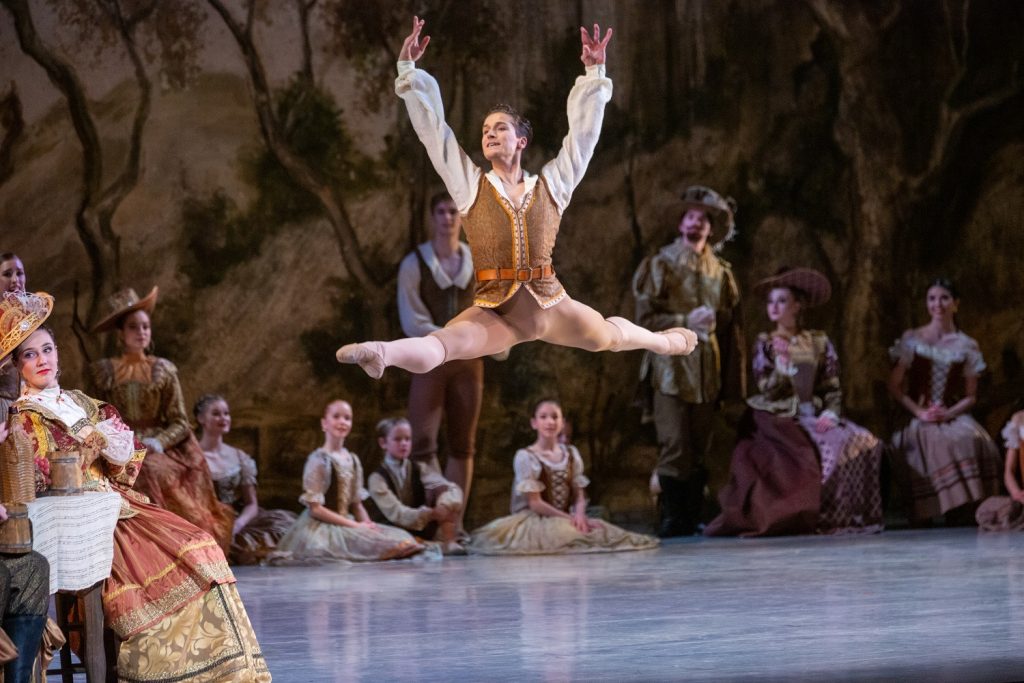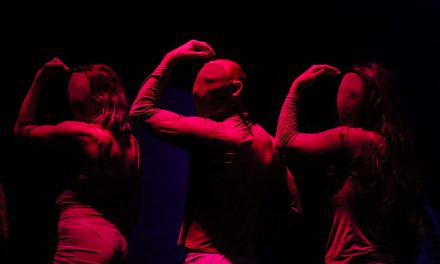Who hasn’t heard of Giselle? The truth is most people outside of the ballet world are unfamiliar with the work because its name and soundtrack haven’t quite reached the heights of The Nutcracker or Swan Lake. Regardless, Giselle (1842) is a classic and its February 4 stint at The Soraya not only served to expose more audience members to the ballet, but also became a fantastic showcase for a company never before featured on the venue’s stage — Salt Lake City’s Ballet West, whose ensemble’s quality of movement was exquisite, particularly in the case of lead dancers Beckannee Sisk and Chase O’Connell.
For those unfamiliar with the story, the romantic ballet set in a small Medieval German Rhineland village centers on a peasant girl named Giselle (Sisk) who falls in love with Albrecht, Duke of Silesia (O’Connell) initially disguised as a peasant named Loys. Also pining for her love is a local young farmer and woodsman named Hilarion (Hadriel Diniz). Due to his jealousy, Hilarion exposes Albrecht’s true identity to Giselle in front of a visiting party of noblemen and hunters, among which is the duke’s betrothed Bathilde (Marge Hendrick). The revelation causes Giselle to go mad and take her own life. The second act revolves entirely around the supernatural world, with Giselle’s potential recruitment as a vengeful Wilis — the ghost of a woman who was betrayed by a man and died before her wedding day. (Fun Fact: today, these creatures are mostly known for being the inspiration behind the enchanting Veela in J.K. Rowling’s Harry Potter Series.)
Sisk shines as Giselle from the beginning. The ballet’s first few, slower story building scenes work in her favor, allowing her to fully embody the essence of Giselle — a gentle-spirit whose innocence leads to her demise. Like many classic ballet female characters, Giselle is not the ideal modern-day heroine. Her frailty and desperation when dealing with disappointment are undesirable traits. However, Sisk is able to play her role with charm. She is coy as O’Connell courts her while retaining the innocence necessary to play games such as “He loves me…he loves me not” without making the segment seem anything other than quaint. She and O’Connell have good chemistry throughout, which helps them build a credible love story through their gentle waltzes and come-hither glances.
Ballet West’s choice to predominantly stick to Jean Coralli and Jules Perrot original choreography (additional choreography and staging by Pamela Robinson Harris with artistic direction by Adam Sklute) serves as the ultimate testament to both performers’ talent. Sisk floats as she glides across the stage. Sweeping arm movements elegantly enhance her and O’Connell’s pantomimed exchanges. Harmonized frappés (a classical ballet term meaning “struck”) add emboldened purpose to their pas de deux.
Group dancing takes center stage during the first act’s Harvest celebration. The initial corps de ballet routine is composed of uplifting temps levé (single foot hops) and balloné (forward-moving single-foot kick jumps), the latter of which is reminiscent of exciting horse kicks well-suited to the ballet’s country cottage backdrop (sets by Peter Cazalet). The ensemble’s best moments take place after the arrival of the hunting party, among whom is Bathilde. The plot’s call for the villagers to impress the nobles results in a very entertaining pas de quatre (Jenna Rae Herrera, Chelsea Keefer, Alexander MacFarlan and Jordan Veit) full of partner switches and rich movement that emphasizes the vivacity in Adolphe Adam’s soundtrack. All four are astoundingly light on their feet, reaching significant heights with every leap. Equally impressive is a follow-up tambourine dance led by Diniz with he, MacFarlan, Veit, and the other male ensemble members’ quick kicks and vibrant spins activating every jingling bell to rhythmically enhance the ballet’s overture.
Like Sisk and O’Connell, Diniz is a strong lead. His bold movements capture Hilarion’s gruffer origin, while still maintaining a sense of nimbleness and precision in execution. Regarding acting, which seems to play a larger role in this ballet than it does in many others, he is able to make the viewer sympathize with his character while disliking his choice in actions. His smug reveal of the duke’s status and fiancée is the catalyst to Giselle’s downfall and the entire second act.

Ballet West – Beckannee Sisk and Chase O’Connell and Company in “Giselle” – Photo by Luis Luque /Luque Photography
Upon finding out the truth, Sisk artfully portrays the protagonist’s descent into madness with faints and schizophrenic recreations of the flower game she played when being courted by “Loys.” Her suicide via stabbing with Albrecht’s own knife accentuates the tragedy of her death, properly subverting the censoring tactic many companies have unfortunately adapted over the years involving the decision to have Giselle die due to shock
Act II almost seems like a completely different ballet, both in movement and story. This production includes a brief flash of a prediction about the dangers of the Wilis by Giselle’s mother Berthe (Jane Wood), who was careful to warn Giselle not to overexcite herself from the beginning, foreshadowing the first act’s ending.
The forest scenery (courtesy of Louisville Ballet) and Giselle’s isolated grave is an excellent setting for the Wilis, whose vindictive spirits traditionally would more easily summon Giselle if she were not buried in hallowed ground — a result of her death by suicide. The Wilis’s costumes (designed by Cazalet) match the greenery, creating the look of a white wedding dress tinged with myrtle leaves (the flower of death), and draping off-the-shoulder, torn-looking tulle sleeves that reflect decay. The green on the dresses also distinguishes Giselle, whose pure white gown signifies to the audience that she has not yet joined the wraiths’ ranks.
The Wilis (Lindsay Bond, Jazz Khai Bynum, Lillian Casscells, Isabella Corridon, Jordan Depina, Brigitte Edwards, Nicole Fannéy, Olivia Gusti, Savannah Lyle, Amber Miller, Kazlyn Nielsen, Ginabel Peterson, Grace Anne Pierce, Jordan Richardson, Victoria Vassos, Kristina Weimar, Claire Wilson, and Severina Wong) display immense synchronicity during their woeful numbers, which encompass the entire arena. Their swinging arms and well-timed footwork make their dance appear to be more ritualistic, especially as the groups split in two and weave through each other via off-pointe hops, dominating the stage as their own.

Ballet West – Beckannee Sisk and Chase O’Connell in “Giselle” – Photo by Luis Luque /Luque Photography
Giselle’s ghostly pas de deux with Albrecht as he visits her grave is at once more complicated and further beautiful than their encounters when she was alive. The couple’s lack of eye contact due to his inability to see her adds a melancholy, but romantic cast over their tight lifts and purposely thudded stomps. The sound of their pointe shoes echo the frustration both experience apropos their fate as lovers.
The one moment which slightly fails to live up to expectation is the effect of the Wilis’s attack has on the men, particularly Hilarion, who is visibly unable to escape their clutches, but simply disappears without providing a clear indication as to the cause of his death. A few chest grabs he and Albrecht mime in response to being made to dance without pause hint at their impending (and almost-impending) doom. However, Hilarion’s death in particular seems underplayed — perhaps because his character is slightly less important considering his role as the rejected love interest, and because his backfired unsavory plan of exposing Albrecht to Giselle is the direct cause of her undeserved ending.

Ballet West – “Giselle” – Katlyn Addison as Myrthe, the Queen of the Wilis – Photo by Luis Luque /Luque Photography
Myrthe, the Queen of the Wilis (Katlyn Addison) is a pillar of authoritarian mercilessness. Addison’s stoic face and harsh signaling gestures sell her role as an ancient spirit: the first woman to ever be jilted by her partner before their wedding, and whose soul then enlists others like herself in the hopes of destroying more men. Her henchwomen and first recruits, Moyne (Emily Neale) and Zulme (Gabrielle Salvatto) are also incredible dancers, more than suited to represent their clan’s power and gloominess.
Sisk’s performance throughout the second act are even more spectacular than during Act I. Her first appearance to the Wilis as a frazzled specter shows amazing speed, agility, and balance — especially as she shifts her weight, tilting in one direction, then the other as she leaps upward and forward toward the audience. She and Albrecht, like Hilarion before them, make their ability to keep up with the intense speed at which the Wilis force the duo to dance appear effortless.
Giselle’s choice to stick with Albrecht until the end, shielding him from the Wilis who are forced to leave at sunrise, adds a layer of strong will to the character. Her stubbornness and eventual forgiveness give her weak constitution new life in death. Albrecht is saved and her soul is liberated from the phantoms thanks to her resilience. Her final fade into her beautifully lit, translucent grave (lighting design by Joseph R. Walls) at the very end is satisfying because the act itself does not call for one last, tearful goodbye. The prince’s destiny to regret his lie for the rest of his life is felt even more strongly because she leaves him rather unceremoniously.
Ballet West’s production serves as a good introduction of this timeless classic to first-time viewers. Aside from exhibiting a marvelous troupe of dancers, the raw feel of the performances helps amp up the drama from a weepy to damsel-in-distress-feels-compelled-to-save-her-lying-partner story to a more empowering tale of clemency and compassion. Here’s hoping the company returns soon to an LA stage soon.
Written by Lara J. Altunian for LA Dance Chronicle, February 12, 2020.
To visit the Ballet West Website, click here.
To learn more about The Soraya Theatre, click here.
Featured image: Ballet West – Chase O’Connell as Prince Albrecht in Giselle – Photo by Luis Luque/Luque Photography












